54 F. average high on April 14 in St. Cloud.
13 hours, 26 minutes, 21 seconds of daylight on April 14.
+ 4 hours, 40 minutes, 14 seconds of additional daylight at STC since December 21.
1-2" slushy snow possible early Saturday (2-3"+ possible in the suburbs). Whatever falls should melt by late morning.
2/10th's of additional snow and this will become the 4th snowiest winter on record for the Twin Cities.

* Important Note: I've said it before, but it bears repeating: do not rely on (just) the emergency sirens to get tornado warnings. If you do you're putting yourself and your family at heightened risk. The sirens were designed for outdoor use only. They were never meant to be heard indoors. I'm always a little shocked at the number of otherwise rational, logical people who tell me "I go to the basement when I hear the sirens." Bad idea. You should have "multiple safety nets" when it comes to severe weather. That means:
TV/Radio
NOAA Weather Radio (still the best, cheapest form of life insurance you'll ever buy. They start at $25-30.
Internet/E-Mail Alerts. There are many free services you can sign up for so you'll get an e-mail if a warning is issued for your specific county.
Smart Phone Apps: on Android and iTunes you can download apps that send out warnings - many are free.
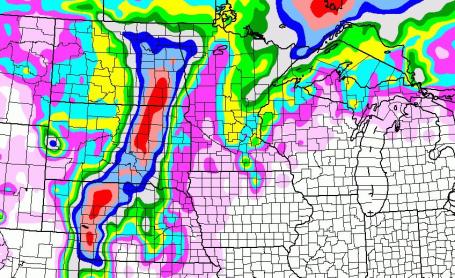
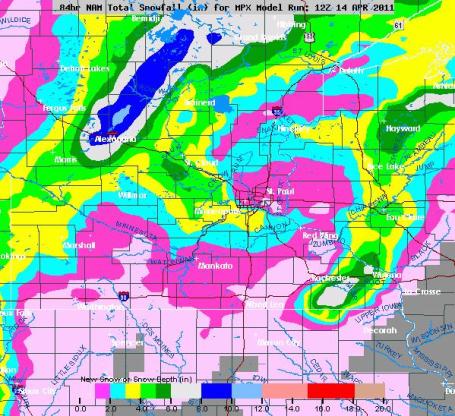
Big Variations. The latest NAM model shows the heaviest amounts of slush possible over parts of central Minnesota , where some 1-3" amounts are possible late tonight into Saturday morning. A narrow band of 3-6" is possible from Alexandria to Wadena and the Leech Lake area.

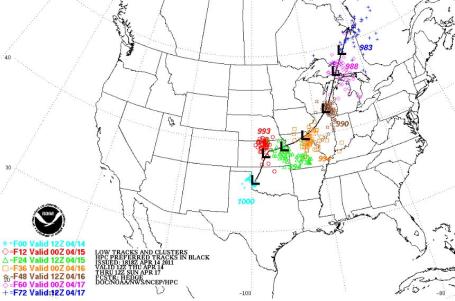
Storm Track. The models are all in pretty good agreement about the track of today's storm, still favorable for a changeover from rain to snow. If precipitation were to fall as all-snow we'd wind up with about 3-4" of slush, but I still suspect there will be enough warm air in the lowest mile of the atmosphere for a cold rain during the evening and early nighttime hours.
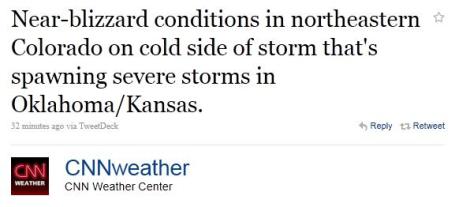
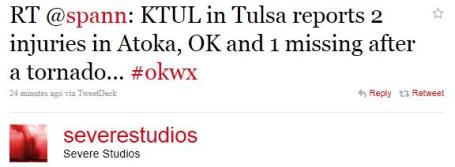



Earth Had 13th Warmest March On Record. The very latest from NOAA: "The Earth experienced the 13th warmest March since record keeping began in 1880, as the climate phenomenon La Niña continued to be a significant factor. The annual maximum Arctic sea ice extent was reached on March 7 and tied with 2006 as the smallest annual maximum extent since record keeping began in 1979.
- The combined global land and ocean average surface temperature for March 2011 was the 13th warmest on record at 55.78 F (13.19 C), which is 0.88 F (0.49 C) above the 20th century average of 54.9 F (12.7 C). The margin of error associated with this temperature is +/- 0.13 F (0.07 C).
- Separately, the global land surface temperature was 1.49 F (0.83 C) above the 20th century average of 40.8 F (5.0 C), and tied for the 12th warmest March on record. The margin of error is +/- 0.15 F (0.27 C).Warmer-than-average conditions occurred across most of Siberia, southwestern Greenland, southern North America, and most of Africa. Cooler-than-average regions included: most of Australia, the western half of Canada, most of Mongolia, China, and southeastern Asia."
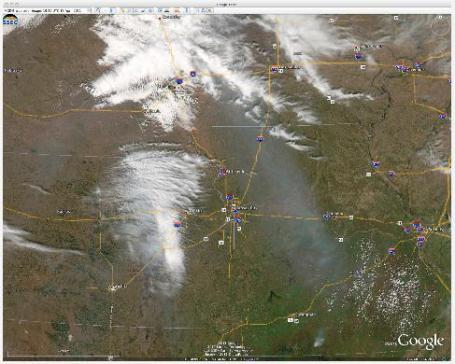
Kansas Brushfires Spread A Pall Of Smoke Over Missouri. Look carefully and you can see a blue-gray smear of smoke spreading across Missouri, blown aloft from fires over eastern Kansas. The University of Wisconsin CIMSS Weather Blog has the details: "An AWIPS image of POES AVHRR 3.7 µm shortwave IR data (above) revealed a large number of fire “hot spots” (black to red to yellow pixels) across much of eastern Kansas on 12 April 2011. The majority of these were grassland fires. On the following day (13 April 2011), a well-defined area of dense smoke aloft could be seen stretching from Missouri into southwestern Iowa on a MODIS 0.65 µm visible channel image."

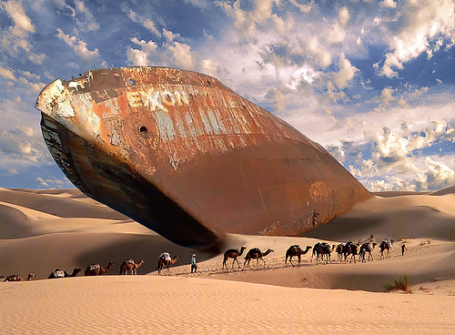
Believers In "Peak Oil" Preparing For When A Fill-Up Costs $100. Gas is already hovering at $4/gallon; it's not hard to imagine $5/gallon gasoline in the not-too-distant future. Here's an article from Hawaii's staradvertiser.com: "Another energy expert, Fereidun Fesharaki, East-West Center petroleum expert and a senior fellow, predicts $200 barrel gallon oil within five years. At that price you will be paying $6 a gallon at the pump. Fesharaki puts $400 worth of gas in his car every month to power his commute from Mililani. The rational driver should expect to pay between $800 and $1,000 as oil prices continue to rise, he says. In much of Europe, where gas is already more than $6 a gallon, much of the price is taxes. In fact, Fesharaki suggests that one way to trim our oil addiction is to tax it out of us. Somehow I don't see that happening, although taxing us into an "oil scared straight" program does have its local supporters."


Antarctic Lake Hides Bizarre Ecosystem. A fascinating article from wired.com: "In the eerie bluish-purple depths of an Antarctic lake, scientists have discovered otherworldly mounds that tell tales of the planet’s early days. Bacteria slowly built the mounds, known as stromatolites, layer by layer on the lake bottom. The lumps, which look like oversize traffic cones, resemble similar structures that first appeared billions of years ago and remain in fossil form as one of the oldest widespread records of ancient life. The Antarctic discovery could thus help scientists better understand the conditions under which primitive life-forms thrived. “It’s like going back to early Earth,” says Dawn Sumner, a geobiologist at the University of California, Davis. Sumner and her colleagues, led by Dale Andersen of the SETI Institute in Mountain View, California, describe the discovery in an upcoming issue of Geobiology. “These are just incredibly beautiful microbial landscapes,” she says. Researchers have probed many Antarctic lakes to study the weird and wonderful microbes that live there. Andersen alone has dived into at least eight such lakes. But he says the discovery of the stromatolites rocketed East Antarctica’s Lake Untersee “to the top of my list.”


Aerobie Aero Press $21.72
The Aero Press makes great espresso-strength coffee in under a minute! Just pour in hot water and coffee grounds, mix, then press it all through the filter you can vary the strength of your coffee by mixing or pressing it longer. It creates a vacuum seal to really pressure the water through the coffee, so it's a much stronger taste than the traditional French press coffee. Cleanup is also really easy, since the grounds and the filter are compacted into a cookie-like wad, and the Press' parts are all made of dishwasher-safe plastic. A pack of 350 replacement filters sells for just $5.
Oster Electric Wine Bottle Opener $17
Opening a wine bottle is hard work (really?), but the Oster electric wine opener makes it dead simple no twisting required. Place it onto the top of the wine bottle, press a button, and in 10 seconds the cork is extracted; absolutely no human effort required. The Oster Electric Wine Bottle Opener can open 30 bottles on a single charge, and it has a rechargeable battery.


Raw Thursday. Under a mostly-gray sky the mercury only managed to reach 48 in the Twin Cities on Thursday, 8 degrees below average. St. Cloud registered 47, 49 in downtown St. Paul.

TODAY: Raw and windy, cold rain develops later in the day. Winds: E 15-30. High: 47
FRIDAY NIGHT: Rain changes to sleet, then wet snow (after midnight). Low: 30
SATURDAY: 1-2" slush early (more possible in the outlying suburbs), then slow clearing. Whatever snow falls should have melted by early or mid afternoon. High: 44
SUNDAY: Sun returns, hello spring! Low: 32. High: near 50
MONDAY: More rain. Wet snow far possible far north. Low: 33. High: 49
TUESDAY: More clouds than sun. Low: 37. High: 52
WEDNESDAY: Intervals of sun, quiet. Low: 39. High: 55
THURSDAY: Growing chance of showers. Low: 40. High: 54

Dueling Models
"My friend wanted to become a meteorologist. Why? He wanted to find a job where he could be wrong every day and still get paid." Great line from the (amazing) movie, "Monsters", which you should Neflix. When did Netflix become a verb? Very funny. Yes, I've heard it a few hundred times.
Weather prediction is an inexact science, unlike economics & politics. For any prediction beyond 24 hours we rely on weather models, scores of them. Some work better in certain scenarios; all have their strengths & weaknesses.
On the Star Tribune weather blog I show all the solutions; it doesn't mean I agree with what they're saying. "Hey Martha, Paul is predicting 42" of snow!" I'm trying to show how we assess the various models to create (and fine-tune) a forecast over time. As new data arrives the forecast invariably changes. Frustrating? Yes. But it's the best we can do with the tools at hand. Today's 5-Day forecast is as accurate as a 3-Day prediction was 30 years ago.
A cold rain later today ends as a couple slushy inches early Saturday. No worries; whatever snow winds up in your yard should melt by late morning. Rain (and 50s) return next week as spring stages a valiant comeback.
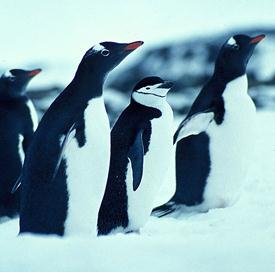
No Winners Among Penguins As Antarctic Warms. Scientific American has the latest: "The number of Adelie and chinstrap penguins living on the Antarctic Peninsula has plummeted by more than half during the past 30 years. Scientists once believed that climate change would create a stark contrast between the two species. Ice-loving Adelies, which winter on sea ice, would see their numbers dwindle as their habitat warmed, the thinking went. Ice-avoiding chinstraps, which prefer open water, would thrive. But the new study suggests that picture was only half right. Populations of both penguin species have plummeted in recent years, which the research blames on the loss of the tiny, shrimp-like krill that are a staple food for both birds. The amount of krill near the Antarctic Peninsula has fallen by 38 to 81 percent over the past three decades as the region has warmed. With less food available, fewer young Adelie and chinstrap penguins alike survive to maturity, said the new study's lead author, wildlife biologist Wayne Trivelpiece of the National Oceanic and Atmospheric Administration."

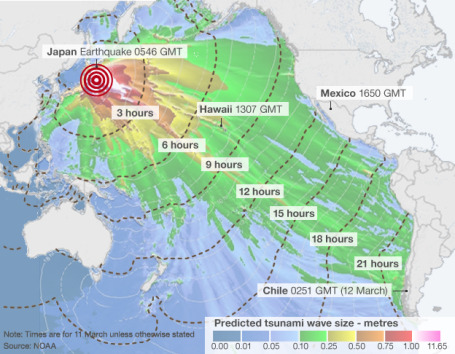
No comments:
Post a Comment